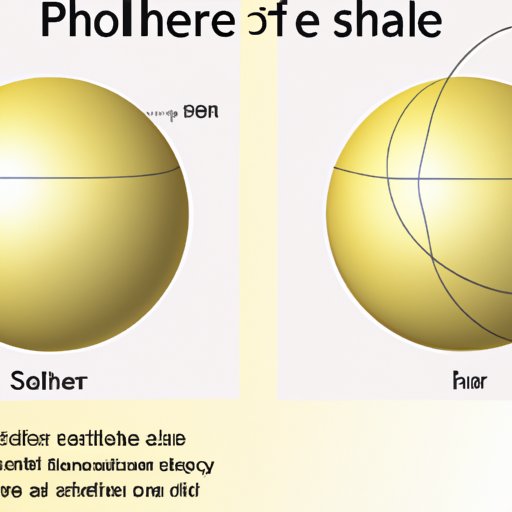Introduction
Spheres are a shape that can be found in many different objects in the world around us, from planets and stars to sports balls and medicine capsules. If you need to find the volume of a sphere for a project or job, it’s essential to know how to calculate it correctly. In this article, we will delve into the mathematical formulas and concepts you need to understand to answer that question.
Unlocking the Mathematics of a Sphere’s Volume
When we think of a sphere, we usually picture a round object with no flat surfaces and uniform curvature. It is a symmetrical solid with dimensions that require specific mathematical formulas to determine its volume accurately. Before we tackle the formula for calculating the volume of a sphere, let’s review some of the properties associated with them.
A sphere is a 3D object, and its surface is considered a two-dimensional geometric shape. In contrast, a circle is a two-dimensional shape with no thickness. A sphere has a center point, and outer surfaces are equidistant from its center. This equidistance is known as the radius of the sphere. The diameter of the sphere is the straight line that passes through the center point and extends to its outermost points.
The Geometric Formula for Finding the Volume of a Sphere
Now, let us dive into the formula for calculating the volume of a sphere. The formula is as follows:
V = (4/3)πr³
where V is the sphere’s volume, r is the radius of the sphere, and π (pi) is a constant equal to approximately 3.14159. The formula shows us that the sphere’s volume is directly proportional to the cube of its radius.
Three Different Approaches to Finding the Volume of a Sphere
There are different approaches to deriving the formula mentioned earlier for calculating the sphere’s volume. One method involves a physical experiment that measures displacement, while another uses calculus, and a third dissects and rearranges the sphere to find the volume. In the Calculus method, the volume of the sphere is considered as a sum of smaller volumes that approximate the sphere’s shape. Then, the limits of the sum approach the limits of the volume of the complete sphere, providing a formula. In the Dissection method, the sphere can be divided into smaller cones and cylinders that can be rearranged to generate a more straightforward formula.
Mastering the Art of Calculating Sphere Volume in No Time
Learning how to calculate the volume of a sphere is not difficult, but it does require some practice. If you have a calculator and remember the exact value of π, you can calculate the sphere’s volume in no time using the formula mentioned earlier. The primary trick is to simplify the equation based on the radius you’re provided, and you can break it into simpler calculations that you can then solve. The formula is not only essential for solving math problems, but it has practical applications as well.
The Importance of Knowing How to Find the Volume of a Sphere
Understanding the mathematical principles behind the sphere’s volume is essential, and this information is widely used across different fields. For example, it is used in designing water tanks, calculating doses for medication, designing lenses, and building prosthetic limbs, among others. Additionally, it is vital for people who work in 3D modeling and animation, engineering, manufacturing, architecture, and game design. The sphere’s properties form a foundation in the fields of geometry and topology.
Sphere Volume Calculation: A Beginner’s Guide
To calculate the sphere’s volume, follow these step-by-step instructions:
1. Measure the radius of the sphere (or its diameter).
2. Take this radius and cube it, then multiply it by π (approx. 3.14159) and 4/3.
3. The answer is the sphere’s volume in cubic units.
Conclusion
Understanding the sphere’s properties is essential in many applications, ranging from science and engineering to mathematics and more. Remember, the volume of a sphere is determined by a straightforward but important formula, and with practice, it quickly becomes easier to calculate. With the knowledge you’ve gained in this guide, you’re now equipped to explore more complex problems related to spheres. So keep practicing, and you can apply this valuable information in your work and everyday life.
